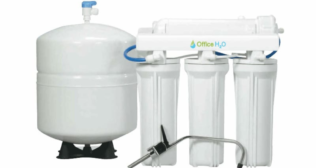How a Reverse Osmosis System Works

Have you ever pondered the inner workings of that sleek reverse osmosis system gracing your countertop or floorspace? Buckle up as we embark on an illuminating expedition, unraveling the captivating science behind the creation of clean, pure water.
From heavy metals to brackish water, our journey reveals the remarkable prowess of RO technology. Witness as water passes through a labyrinth of advanced filters, meticulously stripping away impurities, and emerging as crystal-clear, refreshing drinking water. Then discover how Office H2O makes having an RO system even easier with routine maintenance and filter changes.
What is a Reverse Osmosis System?
A reverse osmosis (RO) system employs a reverse osmosis membrane to meticulously eliminate impurities, contaminants, and particles from water. This efficient process, driven by applied pressure, compels water molecules to traverse the semipermeable membrane, effectively separating substances such as minerals, salts, and pollutants. The outcome is a pristine, mineral-content-balanced clean water source, ready for safe consumption, cooking, and other uses. Furthermore, activated carbon in the system enhances overall purification efficacy, ensuring an optimal and refreshing outcome.
Step-by-Step Process of Reverse Osmosis
The step-by-step process of reverse osmosis is a harmonious interplay of precision mechanisms. From the initial layers of pre-filtration to the final collection of purified water, each stage contributes to the creation of remarkably clean, safe, and high-quality water.
1. Pre-filtration
Before water even reaches the main RO membrane, it undergoes preliminary filtering.
-
- Sediment Filter: Think of this as the bouncer at the door. This filter catches and removes larger nuisances like dirt, sand, and silt.
- Activated Carbon Filter: Chlorine might be good for pools, but it’s not so great for drinking or for the sensitive RO membranes. This filter effectively removes chlorine and other contaminants, setting the stage for the RO process while also improving water’s taste and odor.
2. The Reverse Osmosis Membrane
At the heart of the system, this semi-permeable membrane works tirelessly. As water is pushed through, it allows pure water molecules to pass while blocking larger contaminants, including salts and harmful bacteria, leaving them behind.
3. Post-filtration:
Even after the rigorous RO stage, the journey isn’t over. Water then travels through an activated carbon post-filter to guarantee that every drop you drink is refreshing. This ensures any lingering tastes or odors are effectively neutralized and you’re left with a great-tasting glass every time.
4. Storage Tank
RO is a diligent but slow worker. Thus, the purified water is stored in a tank, ensuring you get your water instantly whenever you turn on the tap. Our standard drinking water tanks can hold roughly 2-3 gallons of water, while our larger industrial tanks hold more.
5. Drain/Reject
Not all water that flows through the RO systems makes the cut. Because the RO process separates contaminants, it must then channel them away in wastewater. It’s a necessary aspect, though it does mean some water wastage.
Optional Additions
Some RO systems come equipped with extra stages for added benefits:
-
- Ultra-Violet (UV) Disinfection: For those who want to ensure absolute purity, some systems include UV lights. These lights zap and neutralize any bacteria or viruses that might have sneaked past the RO membrane.
- Re-mineralization/Alkaline Stage: RO is so efficient that it even removes beneficial minerals. To counteract this, some systems reintroduce essential minerals, enhancing taste and making the water more alkaline, which many believe comes with health benefits.
Applications of Reverse Osmosis
Reverse osmosis systems are incredibly versatile, catering to residential and industrial water treatment needs, encompassing purification, desalination, and specialized applications. Its adaptability extends beyond conventional uses, making it an indispensable tool in ensuring clean, safe, and sustainable water resources for a wide array of contexts.

Drinking Water Purification
RO plays a pivotal role in safeguarding the safety and purity of drinking water. These advanced systems possess a remarkable ability to combat an array of contaminants that often undermine water quality. With precision akin to a skilled artisan, RO proficiently eliminates harmful bacteria, viruses, and unwelcome chemicals, while also deftly stripping away undesirable minerals. The outcome is more than just a visual transformation – it’s a transformation that ensures the absence of potential health hazards.
Industrial Processes
The versatility of RO extends beyond homes and small businesses, infiltrating various industries as an indispensable tool for water treatment. Other industrial uses include medical facilities, dental offices, and pharmaceutical manufacturers. RO systems rise to this challenge, serving as robust guardians against contaminants that could jeopardize delicate processes and compromise final products.
Take Advantage of Our Reverse Osmosis Systems
When you need a reliable water source for drinking, cooking, cleaning, and operating business, turn to Office H2O. Not only do we have standard RO systems, but we also have RO Deionized setups, as well. Dedicated to the purification of your drinking water, we guarantee you’ll love partnering with us.
Worried about just your drinking water supply? Ask us about our bottleless water and ice coolers! Get started with a free 7-day trial and find out why more than 600K across the Midwest are raving about Office H2O.
Credits:
Photo by Elle Hughes
